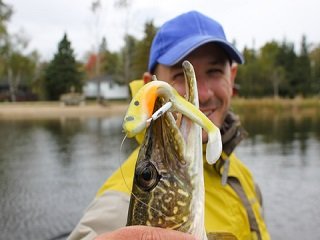 Lures and baits are designed to mimic real world prey and entice fish to strike, and they do this in spades. However, sometimes it’s necessary to make a few modifications here and there to your favorite lures in order to boost their effectiveness. Today we’ll take a look at how you can do this with plastic swimbaits to attract more bites and bring more fish to the boat.
Lures and baits are designed to mimic real world prey and entice fish to strike, and they do this in spades. However, sometimes it’s necessary to make a few modifications here and there to your favorite lures in order to boost their effectiveness. Today we’ll take a look at how you can do this with plastic swimbaits to attract more bites and bring more fish to the boat.
One of the most popular ways to rig a swimbait is with a wide-gap hook with a weighted shank, which creates the stability necessary for the bait to run true. After a while, though, the bait can become damaged as the hook breaks free during a strike or the fight, which often results in a split nose. When this happens, not even the corkscrew mechanism on the hook will remain attached to the bait. You can add some life to a swimbait that’s been damaged in this way with bit of superglue, which will put the nose back together and help the bait hold its own for another fish or two. You can last a few more additional fights if you glue the screw lock itself to the swimbait’s nose.
Aside from repairing torn swimbaits in the boat, you can also make some repairs at home. For instance, you can heat a paper clip over a flame and use it to soften the plastic on the inside edges of the tear. Then, squeeze it together for a bit and you’ll extend its life for a few more trips.
There are times when you have to make modifications because the fish just aren’t in the mood to bite. If you find that bass aren't getting their mouths around the bait, it can help to downsize in a way. For instance, trimming away a bit of the swimbait’s belly fat reduces the amount of material a bass needs to compress in order to get a good hold on the bait. To do this, simply cut about 1/8 inch off the length of the swimbait’s belly. You can also use scissors to carve a slight indent on the top of the bait to expose more of the hook, which I’ve done several times to great effect.
Finally, you can also nip off about 1/8 inch from the nose of the swimbbait to create a square surface. This will allow the bait to easily fit against the flat shoulder of a mushroom head, which is deadly in open water where you can get away with an exposed hook. Keep in mind when you’re trimming a swimbait, though; it won't swim properly if you cut too much.
A few snips here, or a trim there can really add some life to your swimbait and offer a presentation that bass aren’t used to seeing. Many anglers never even think to bend or cut into their lures, out of fear of damaging them, but when you incorporate a “less is more” mentality during the modification process, you’d be surprised at how effective such tweaks can be.








